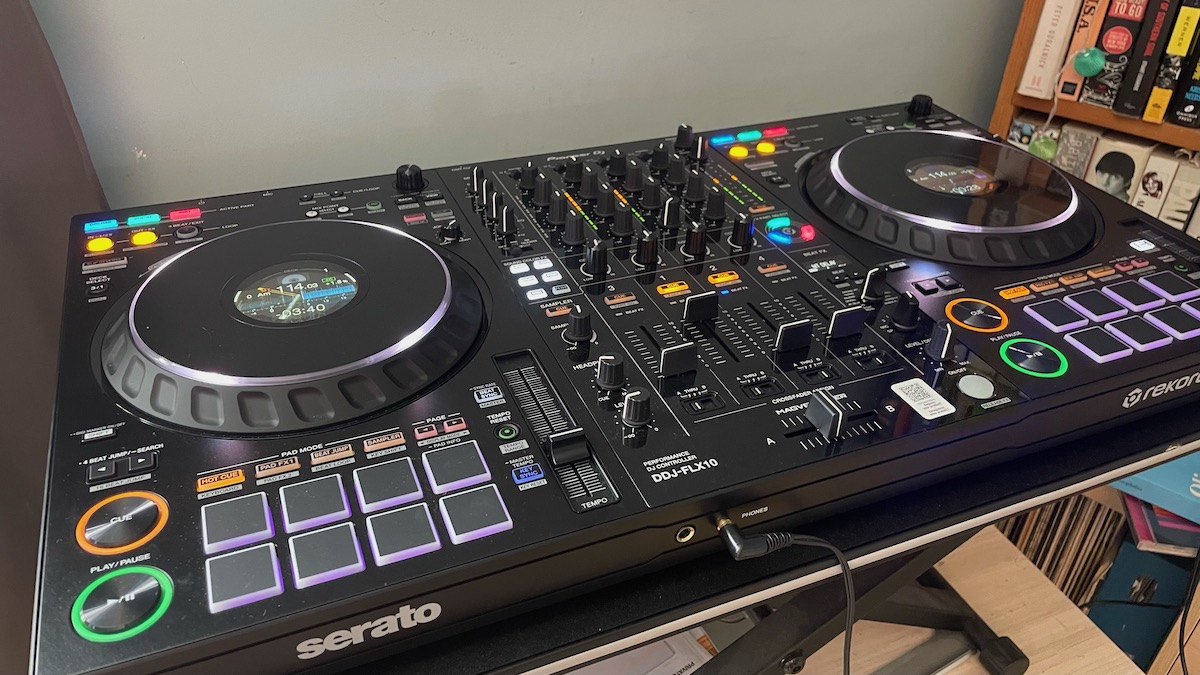MusicRadar Verdict
With its high level of functionality, industry-standard appearance, new track separation technology and multi-platform compatibility, the Pioneer DDJ-FLX10 is like a stripped-down version of a pair of pro-level CDJs, and is a powerful and flexible unit that’s hard to beat at this price point.
Pros
- +
High level of functionality
- +
Stem separation integrated very well
- +
Familiar industry-standard layout
- +
Compatible with Rekordbox and Serato
Cons
- -
Stem separation doesn’t always sound great
- -
No balanced inputs
- -
More expensive than the unit it’s replacing
- -
External ‘brick’ power supply
- -
Can’t adjust crossfader tension
MusicRadar's got your back
Pioneer DDJ-FLX10 review: What is it?
The DDJ-FLX10 is Pioneer’s new flagship DJ controller for performance, replacing their DDJ-1000 and DDJ-1000SRT units. Its cost (currently around $1,600/£1,400) puts it at the higher end of home DJ units, occupying the space between amateur/beginner controllers and a fully-fledged pro set-up, and it comes packed with features to match the price point.
It’s a four-channel performance controller, in the standard club configuration of a pair of decks with full-sized performance pads, a mixer section in the centre, separate three-band EQ for all four tracks, and Beat FX and Sound Colour FX sections. It has one balanced XLR master output, two RCA master outs, TRS booth and DMX outputs, along with two stereo line/phono inputs, two USB-C ports, a pair of mic inputs, and 1/4” and 3.5mm headphone connections.
New developments on the FLX10 include the addition of multi-mode displays on the jog wheels, an improved Magvel crossfader, DMX connectivity for lights, a new 'Stretch' Beat Effect, two additional Sound Colour FX, and an automatic mix function called Mix Point Link.
However, the two biggest innovations here are the inclusion of real-time stems (or ‘track separation’ in Pioneer-speak) tech and dedicated controls, along with Rekordbox and Serato compatibility.
Pioneer DDJ-FLX10 review: Performance & verdict

I found the FLX10 to be slightly larger and heavier than its predecessor but still light enough to carry around if needed. The main case is plastic but the overall build feels robust enough, and the jog wheels, faders, knobs, pads, inputs and outputs all feel reassuringly solid. The crossfader has been improved from a two to four sensor system for more sensitivity and there’s plenty of space around it, making it ideal for scratching and turntablism.
Personally, I’d like the option to adjust the crossfader tension like you can on the nearest competitor, which is the Rane Four, but although you can adjust the curve in Rekordbox or Serato settings I couldn’t find a way to adjust the tension, so you’re stuck with a scratch-style ‘loose’ crossfader.
The Rane Four compares very favourably with the FLX10, although it's a Serato-only unit while the Pioneer is primarily a Rekordbox controller which also has near-perfect Serato implementation (we only tested the unit with Rekordbox but reports suggest there are a couple of small areas where the FLX10 doesn’t map exactly to Serato and the Mix Point Link function isn’t available in Serato at all).
Unlike the Pioneer, the Rane has balanced inputs, the case is metal, comes with a standard IEC socket and lead, and in our tests was the best DJ controller in terms of stem separation. However, the FLX10 comes with a tempo reset button, double the number of external inputs, DMX output for direct lighting control (although only in Rekordbox), and it also possesses another big advantage: its layout and controls, while simpler than a pro CDJ set-up, are similar enough that switching to using CDJs in the club should be completely painless.

The substantial change on the FLX10 from the DDJ-1000 are the track separation controls in the mixer section and above the loop buttons. In short, this function allows live separation of sections of a song, into either drums, vocal or instrument. Once you enable the stems function in your software’s settings, the three colour-coded buttons above the loop buttons and in the Beat FX section become active. All three parts are active by default, then if you hit, for example, the drums button, the drums simply disappear and you can isolate just the vocals, or just the vocals and drums etc. in any combination. It works instantly and easily, and they’ve also included an FX part select function which allows you to apply Beat FX to individual parts, opening up all sorts of creative possibilities. It’s all colour-coordinated with matching side lights on the jog wheels indicating which part is playing and the implementation is impressively accessible and highly usable.
The sound isn’t perfect however, and the isolated parts sometimes sound grainy or a little distorted, although I found that the drums generally sounded fine, and sometimes the isolated vocal or music parts were surprisingly clean. Presumably, the algorithms involved will continually be updated and improved. In the meantime, the FX part select function is particularly impressive and again, very accessible and usable for a bit of live remixing.
The seamless stems integration is also reflected in the general design of the unit, and one of the FLX10’s greatest strengths is its layout and ease of use, with each section clearly delineated from the others, and with enough space to comfortably navigate around the various controls.
The jog wheels now have four visual modes which you can easily switch between using the shift and ‘page’ buttons, allowing you to easily get a close-up look at your waveform if needed, as well as an artwork mode, which will be super-useful for DJs who remember tunes via what the cover art looks like.
Pioneer have also expanded the effects on the FLX10 too. There’s a new ‘Stretch’ Beat FX which does a pretty good impression of that classic 90s jungle timestretch sound, and two new Sound Colour FX, a highly useful ‘Space’ reverb and a ‘Crush’ effect that sounds a bit like filtered ring modulation.
Pioneer DDJ-FLX10 review: Hands-on demos
DJ City TV
Digital DJ Tips
Crossfader
Pioneer DDJ-FLX10 review: Specifications
- Compatibility: rekordbox, Serato DJ Pro
- Soundcard: 24 bit/44.1 kHz
- Channels: 4
- Deck control: 4
- Sampler: 16slot x 4bank
- Hot cues: 16
- Inputs: 2x line (RCA), 2x phono (RCA), 1x mic (XLR & 1/4 inch TRS), 1x mic (1/4 inch TRS Jack)
- Outputs: 1x master (XLR), 1x master (RCA), 1x booth (1/4 inch TRS Jack), 1x phones (1/4 inch stereo phone Jack), 3.5 mm stereo mini jack x 1
- USB: 2x USB-C
- Contact: Pioneer DJ
Harold Heath is a UK music writer and author. A DJ since the late 80s, Harold also produced a few hundred singles and remixes and two artist albums, and worked as a performer, ghostwriter and music-technology teacher. His first book Long Relationships: My Incredible Journey From Unknown DJ to Smalltime DJ was published in 2021.
“Built from the same sacred stash of NOS silicon transistors and germanium diodes, giving it the soul – and snarl – of the original”: An octave-fuzz cult classic returns as Jam Pedals resurrects the Octaurus
What’s the buzz? Meet Yellowjacket, Cherry Audio's recreation of EDP’s trend-setting Wasp from 1978
“A fabulous trip through all eight songs by 24 wonderful artists and remixers... way beyond anything I could have hoped for”: Robert Smith announces new Cure remix album














